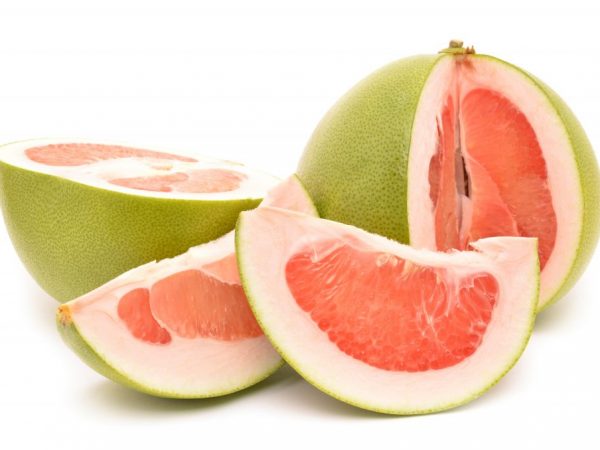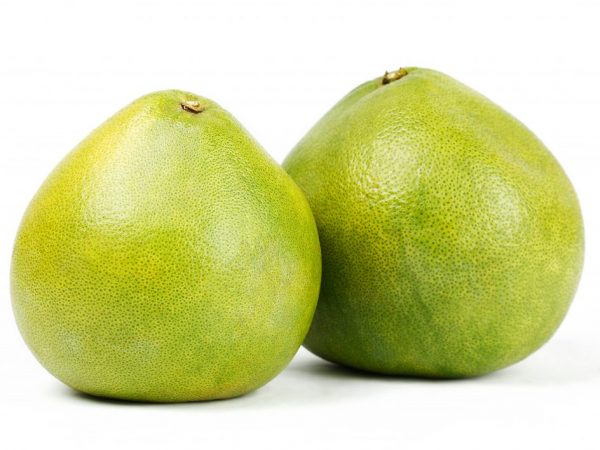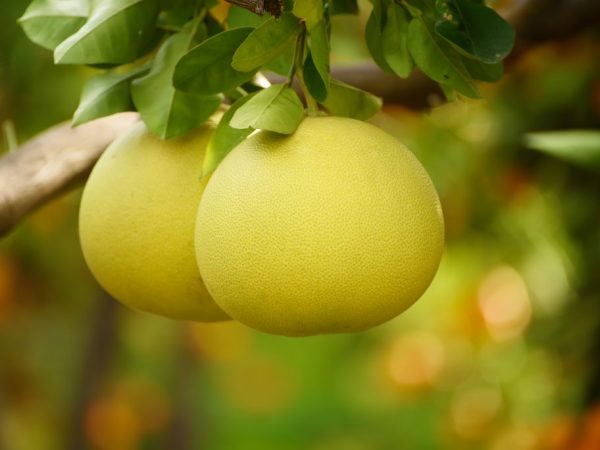Characteristics of pomelo varieties
There are different varieties of pomelo - an exotic, mysterious fruit. It grows on an evergreen tree. This plant is a representative of citrus fruits, is a close relative of orange and grapefruit, but its size is much larger. The product is called in another way pamela, pompelmus, sheddock.

Characteristics of pomelo varieties
Characteristics of the fruit
The first historical information about citrus in China appeared in 100 BC. e. Pomelos were also first grown in Malaysia and Southeast Asia. It was brought to Europe by seafarers in the XIV century. Now the Chinese fruit is grown in Thailand, Taiwan, Vietnam, Japan, India, the Tahiti islands, Indonesia and Israel, the United States (in small quantities).
Pomelo is not a hybrid, but an independent species. But it is used in breeding work. For example, there is a sweet variety (oroblanco, pomelo) - this pomelo is crossed with white grapefruit.
Description of the tree
The plant reaches a height of 15 m. The crown is spherical. The leaves are large. Flowers are single or from 2 to 10 pieces in inflorescences. Their diameter is 4-7 cm, the color is white. fruiting sometimes lasts 7 months.
Description of the fetus
The fruit is large: the weight of the largest specimens reaches 10 kg, the diameter is 30 cm, which is normal for the tropics.
The shape is spherical or pear-shaped. Pomelo is red, yellow, green, pink. Shades range from light green to yellow-pinkish. The skin is thick but easy to peel. The pulp is drier than other citrus fruits and is divided into large slices. The partitions between them are hard, hard to chew, bitter, and white.
The color inside the fruit differs in different species: from red to almost white. There are seeds in the lobules. The taste, from sweet with bitterness to sour, is reminiscent of grapefruit. The aroma is pleasant.
The fruits ripen around February. Consume them fresh, removing partitions. They make candied fruits, add to salads, desserts and even meat dishes. Jam is made from the zest.
The preservation of the fruit is about a month. Keep it in the refrigerator or at room temperature. In a purified form, it deteriorates in 2-3 days.
Fruit varieties
In stores, they often sell green or yellow-green fruits with light flesh. But there are much more species of pomelo. The main varieties include:
- Khao horn - white flesh, yellow-green peel, sweet taste, similar to grapefruit;
- Khao namphung - the inside is light yellow, the color is greenish-orange, the fruit is sweet pear-shaped, reminiscent of a lemon;
- Khao paen - white flesh, divided into 12-15 slices, flattened ball shape, green skin, sweet taste with bitter sour notes;
- Khao phuang - yellowish-white flesh, pear-shaped, green-yellow color, sweet and sour taste;
- Thongdi - pomelo pink inside and dark green on top, spherical shape, sweet taste.
Composition

The fruit contains antioxidants
The fruit contains vitamins of group B, as well as A, C and PP. The composition includes essential oils, antioxidants, enzymes and such trace elements:
- potassium;
- iron;
- calcium;
- sodium;
- phosphorus.
Pomelo has a low calorie content - only 35 kcal per 100 g. Different species do not differ significantly in calorie content. Dried pamela has more of them - 302.8 kcal per 100 g.
Energy value of the product:
- proteins - 0.6 g (∼2.4 kcal);
- fats - 0.2 g (∼1.8 kcal);
- carbohydrates: 6.7 g (∼26.8 kcal).
Percentage: 7%, 5%, 83%.
Beneficial features
Adults are advised to eat no more than 100 g of citrus per day. For children, fruit juice is introduced into the diet from the age of 3. Give a few drops, diluted with water. Its benefits are as follows:
- normalizes blood pressure, heart function, metabolism;
- cleans blood vessels;
- prevents the formation of tumors and atherosclerosis;
- relieves fatigue;
- strengthens the teeth;
- increases efficiency and mood;
- lowers blood sugar;
- raises hemoglobin;
- increases the acidity of the stomach, so digestive enzymes are produced faster;
- serves as the prevention of viral diseases and colds.
Recommended for vitamin deficiency, as well as for people with a problem of excess weight. Since the pomelo is low in calories, it is often used in a variety of diets. In addition, it breaks down proteins and fats, satisfies hunger. For medicinal purposes, not only fruits are used, but also the leaves of the culture. They help with ulcers and also eliminate swelling.
The citrus fruit is also beneficial in the field of cosmetology. Masks are prepared from it, which help to moisturize and nourish the skin.
Harmful fruit

Excessive consumption can cause allergies
In some cases, the pomelo can be harmful. When consuming large quantities of fruit, it is worth considering that it has a laxative effect, and also acts as a strong allergen.
Contraindications to the consumption of the product are:
- individual intolerance;
- increased acidity of the stomach;
- duodenal ulcer, stomach;
- hepatitis;
- nephritis;
- colitis.
Pomelo interferes with the absorption of certain medications or increases their effect. When taking any medication, you should consult your doctor. The product is sometimes harmful in severe pregnancy.
Fruit selection and cleaning
When buying a pomelo, it is worth inspecting its condition. Signs of a quality product are:
- shiny, firm and smooth skin, without build-ups and damage;
- rich pleasant aroma - indicates the freshness and maturity of the pompelmus;
- dense top of the fruit, which does not exceed 1 cm in diameter;
- uniform color - the presence of spots indicates its immaturity.
If the pomelo is burgundy, red or brown, you shouldn't buy such a product. The plant ached during the fruiting period. Although this does not affect human health, it will not please the taste.
Peeling the fruit is complicated by its thick rind. To easily remove it, make several longitudinal cuts up to 1 cm deep. Then, tighten the skin with your finger and remove it. The slices are cleaned from the bitter film.
Conclusion
Of all the citrus fruits, the pomelo is the largest. In order for a huge orange (as many call the fruit) to gain sugars and organic acids, the tree needs to be under the hot sun and abundant rains all year round.
Fruit is healthy and low in calories, which is why many include it in their diet. But it is worth considering the possible risk when consumed, since it can cause harm to the body.


